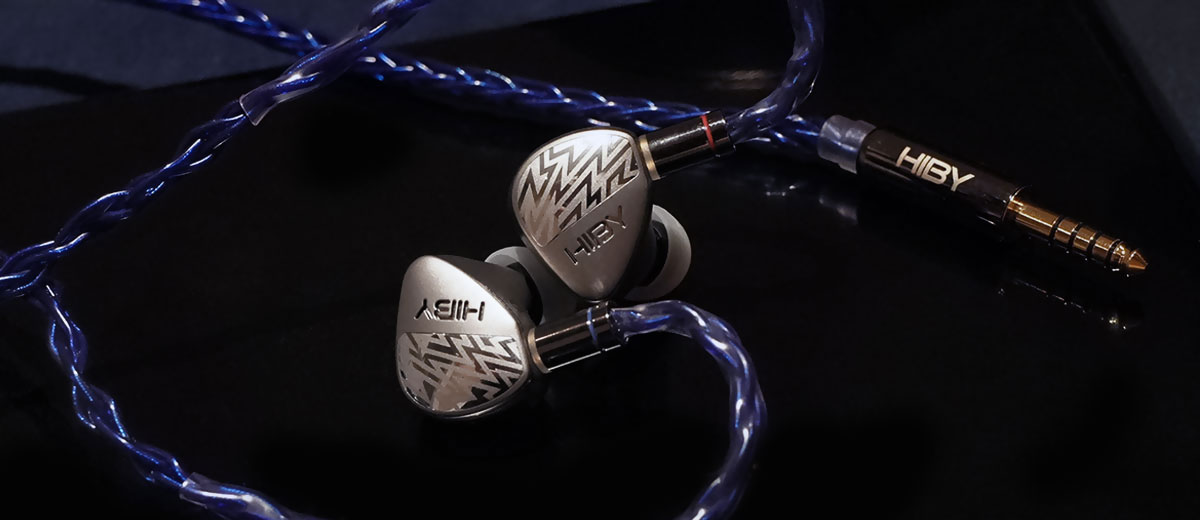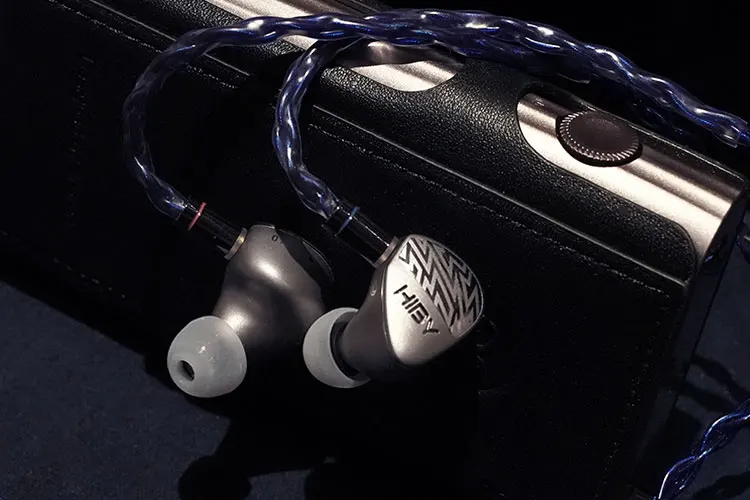Sound Impressions
Like its playful appearance, the Zeta has a full-bodied, dynamic, and slightly V-shaped tuning which delivers strong and punchy bass with good clarity. The bass is rich in details, and there is good density throughout the whole spectrum presented with the tuning leaning towards the low end.
There is a lot of fun finding matching sources for the Zeta which is very responsive to power as well as decoding quality.
This is reflected in the clarity of the vocals, also extension, and micro-details plus the overall tonal balance. When you get the right pairing it is very engaging, though it may sound muffled and skewed with the wrong match, even when it is a pricey, powerful DAP.
To put the IEM and cable in good working condition I have given it more than 100+ hours of run-in before the detailed impressions are made. I am mainly pairing it with dongles as well as the latest HiBy R6 Pro II player for the below impressions.
Bass
HiBy manages to put in a 10mm large, liquid silicone dynamic driver together with the other 8 drivers, which allows the Zeta to deliver strong punch and air that is very enjoyable for metals and anything with big bass.
Testing with the HiBy R6 Pro II, the Zeta attacks with a moderate speed in the lower frequencies and has a rather soft yet clean decay.
Hitting moderately deep, the meaty bass captures the vibes well when replaying live jazz recordings, and it manages to sound well-defined when more energetic bass instruments come into the mix.
Some of the BA drivers are also responsible for the lows and they contribute to the speed in the bass without sounding overly boomy, the transition between the dynamic driver and BAs is quite swift and does not hinder articulation to the mid-range.
Using Imagine Dragons’ “Thunder” to test, the bass punches deep and has a sufficient impact. The power from the low end extends to the lower mids which bestows vocals with stronger power.
In the same way, string plucking and double bass texture are clearly delivered even on small dongles. They are very engaging with woody, shimmering qualities very nicely reproduced.
Mids
The mids is not as forwarded as the lower register but it has sufficient body and penetration power. It cuts through with good clarity due to the boosted upper vocal frequencies, but it is very well-rounded to take away sibilance.
The slightly recessed midrange colors the Zeta calm and a bit towards a monitoring style. I personally find the sweet spot at a slightly higher volume due to the slightly more forwardness in the bass.
With sufficient energy in the lower end, it works well with male vocalists, and also highly rhythmic music, which blends well into the rich underlying bass line.
I personally prefer giving the vocal body a small nudge on R6 Pro II through MSEB. The Zeta shows excellent clarity and better balance even at very high volumes. Darker voices can sound very textured and powerful with lots of air, and you can feel a clear “chest slam” while a clean vocal is delivered.
Being rounded and resolving, the Zeta is quite adaptive to different genres of music and works well with streaming content, to deliver intense, strong dynamics and strengthening texture and definition even at lower sampling rates.
Treble
The Zeta has 4 EST drivers responsible for the treble zone and is capable of delivering detail-rich, highly resolving treble.
With many treble drivers it doesn’t mean that there are piercing highs of high intensity, instead the quantity of treble is well controlled and has good harmony with the lower frequencies. It effortlessly extends the higher frequencies and harmonics without getting hot.
These qualities are more obvious when turning high the volume and you will hear plentiful micro detail and a dense, focused image.
The harmonics from woodwind instruments, strings, or very high-pitched vocals are clearly captured dispersing in the perceived stage rendered, and it is done in a clean and non-intrusive manner.
The EST implementation is successful on the Zeta to deliver good accuracy without adding to the sharpness, there is a good sense of calmness and concentration that matches well with new age music and working BGMs.
Staging & Dynamics
Packing in good density and detail retrieval power, the Zeta has a detailed headroom rendered.
The polite upper mids press down the spaciousness slightly and the full-bodied low frequencies are giving stronger presence to bass instruments such as drums and bass guitars, also letting the subs fill up the space. With decent control, it doesn’t get congested with more instruments in the mix.
The vocal and instruments across the mid-range are smoothly delivered, although it is not as forward and intense as the bass.
With a satisfactory definition in the mids, the Zeta manages to hold together a clear and firm image for different voices, positioning them in front of the listener quite distinctively. It sounds to me like the headroom resembles a small lecture hall as if you are sitting in the middle rows.
The staging performance is quite source dependent and when pairing with a powerful, bassy source the shyer midrange may sound curtained. In other words, the right match of DAPs/dongles will help make the output much more euphonic and balanced, contributing to a more realistic stage experience.
Select Comparisons
Elysian x Effect GAEA
$1299
Technical
The GAEA is a collaboration item between Elysian Acoustic Labs and Effect Audio. The design measures 10ohm in impedance and 102dB in sensitivity, and it has a 4BA + 1DD configuration plus a 4-way crossover design.
The GAEA uses Elysian’s DiVe Pass II design to eliminate internal reflections at the rear chamber and comes with a 24AWG, quad-core UPOCC cable. Compared to the Zeta the GAEA has roughly half the driver count but it is almost as sensitive.
Design
The GAEA adopts a more traditional, resin-crafted enclosure. Comparing the two I think it is an easy win for the Zeta which has a more reliable and premium housing, which is also much harder to machine.
However, the GAEA comes with Effect Audio’s cable which uses pure Copper and SPC as material, and it supports Effect Audio’s ConX system which is overall more convenient.
I believe it is fair to say the Zeta looks one league above the competition, and both units tested are equally comfortable.
Performance
The GAEA comes to my mind immediately when I am preparing for comparisons, mainly due to its sensitivity which allows it to deliver decent clarity without much power requirements.
The two IEMs are tuned very differently and the Zeta carries more energy in both treble and bass, and you can feel the much firmer impact and stronger resolution especially in the lower register.
Comparatively, the GAEA is softer, swifter in articulation throughout the midrange, and more neutrally toned. However, its technical performance is outclassed by the Zeta which has stronger detailing and presence in the lower end of the spectrum. This reveals more micro-detail and renders the stage more realistic and 3D.
The GAEA’s more prominent midrange is, however, friendlier to vocal-intensive tracks and may please those who look for sweetness and presence in the upper register.
With electro-static drivers under its hood, the Zeta is able to deliver more details into the treble zone and give it more texture without introducing more sharpness.
It is also worth noting that, the GAEA has more room to scale with higher-powered devices to upscale its performance. However, you may need to be more careful with the Zeta which is more sensitive to higher-powered devices.
Westone Audio MACH 70
$1399
Technical
The Westone Audio MACH 70 is an IEM of 42Ω, 110dB sensitivity with 7 BA drivers with a 1+2+4 configuration chained together by a 3-way crossover.
The BA-based design, which contributes to better coherence is very different from the HiBy Zeta which uses 3 varieties of drivers and also comes in a more complex crossover design.
Although the impedance looks quite high on the MACH 70, it still feels fairly sensitive while the Zeta has even better synergy on a less powerful source.
Design
The MACH 70 is incredibly light and has a sleek form factor using the T2 connector system and comes with Linum Estron ULTRABaX cables.
Considering the material implemented, the Zeta looks and feels much more premium and sturdier, while the MACH 70 is smaller in size and has a more professional and sleeker appearance. The Zeta also uses 2-pin termination which is more friendly with aftermarket cable upgrades.
Performance
It is fun to compare the two IEMs with strikingly different specs and drivers configuration, but somehow having a similar tuning direction of strong dynamics and firmness.
The MACH 70 has more room to scale with power however the Zeta has some good advantages over it when powered by less powerful sources, to sound more textured and opened up, especially in the treble.
Testing on the RME ADI-2 pro, the Zeta is able to deliver a stronger sense of depth, with sufficient texture and air with its dynamic driver.
The MACH 70 sounds speedier and cleaner in the lower mids, it is almost as punchy though its body is not as strong. The bass punch is denser and has a more solid, crispier image on the Zeta, and the MACH 70 sounds not as energetic and firm.
The MACH 70 exhibits smoother articulation than the Zeta and presents the vocals in a more neutral tone. The nasal tones on the Zeta sound more protruded and I like the coloration that helps strings instruments as well as some male singers to stand out more.
Our Verdict
The HiBy Zeta is an impressive IEM considering this is HiBy’s first attempt at making higher-end models. I am also truly impressed with the contrasting housing design that showcases the beauty of Titanium material by partially mirror-polishing the design.
This is a performance that should earn a recommendation for those who are looking for an in-ear monitor with engaging character ideal for lower-power devices.
HiBy Zeta Technical Specifications
- Impedance: 9 ohms
- Sensitivity: 112dB/mW
- Frequency Response: 20Hz-40kHz
- Max Input: 100mW
- THD+N: <1%
- Weight: 10.6g (each earpiece)





